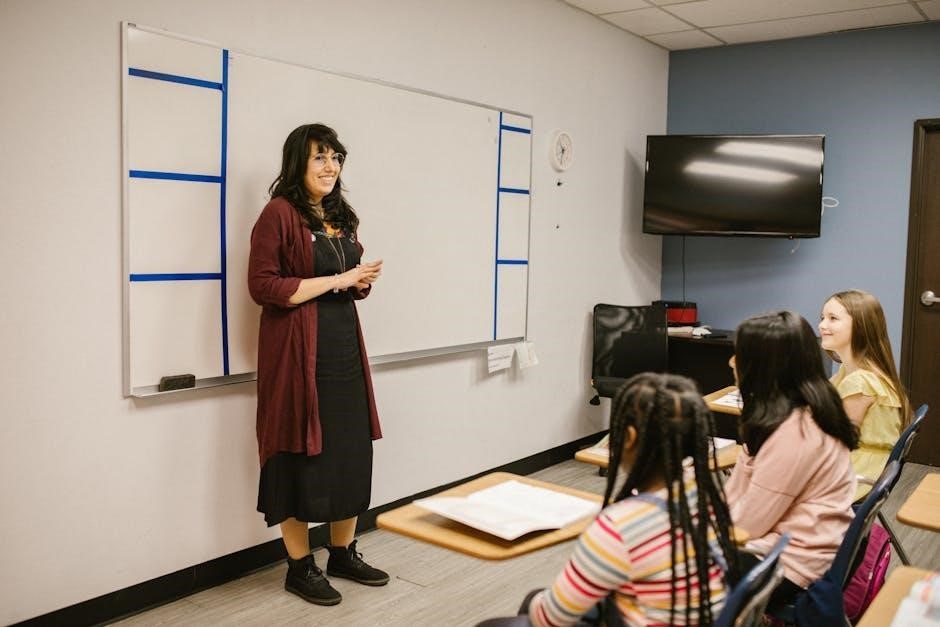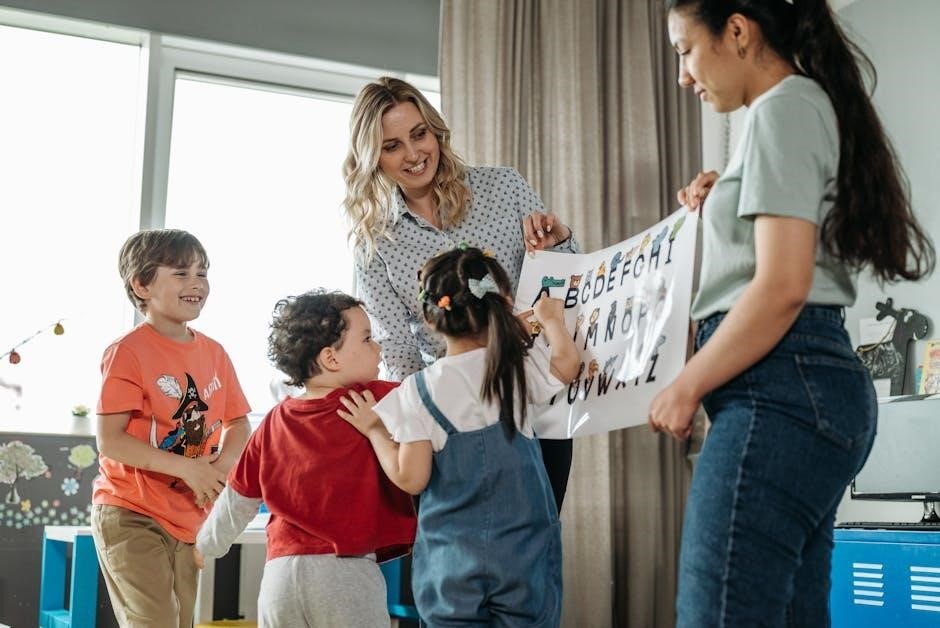
De-escalation techniques are vital for educators to manage conflicts and emotional outbreaks‚ fostering a calm classroom environment. These strategies ensure student safety‚ promote positive interactions‚ and create a supportive atmosphere for learning and growth.
1.1 Importance of De-Escalation in Educational Settings
De-escalation techniques are crucial in educational environments to ensure student safety‚ emotional well-being‚ and academic success. They help educators manage conflicts‚ prevent behavioral escalation‚ and foster a positive classroom atmosphere. By addressing emotional triggers early‚ teachers can reduce disruptions‚ create trust‚ and promote a culture of respect. These strategies are essential for maintaining focus on learning and supporting students’ social-emotional development. Effective de-escalation not only resolves immediate conflicts but also teaches students healthy ways to manage emotions and resolve disagreements. It empowers educators to build stronger relationships with students‚ creating a supportive and inclusive learning environment. Ultimately‚ de-escalation techniques contribute to a safer‚ more productive school community‚ benefiting both students and staff.

Understanding De-Escalation
De-escalation involves techniques and strategies to calm tense situations‚ focusing on active listening‚ empathy‚ and clear communication to resolve conflicts‚ reduce stress‚ and maintain a positive‚ supportive environment for effective learning and growth.
2.1 Definition and Overview
De-escalation refers to strategies and techniques used to calm tense situations‚ reduce conflict‚ and prevent escalation. It involves active listening‚ empathy‚ and clear communication to address emotional or behavioral challenges effectively. These methods are essential for creating a safe and supportive environment‚ particularly in educational settings. By understanding the root causes of agitation‚ educators can employ de-escalation techniques to diffuse stress and foster positive interactions. Key components include maintaining calm‚ using non-verbal cues‚ and providing emotional support. Effective de-escalation not only resolves immediate conflicts but also strengthens relationships and promotes long-term well-being. Teachers who master these skills can create a more conducive learning atmosphere‚ ensuring students feel heard and understood. De-escalation is not just a reactive strategy but a proactive approach to building resilience and fostering a culture of empathy and respect in the classroom. Its application is vital for addressing diverse student needs and ensuring a stable educational environment.
2.2 Recognizing Emotional Triggers
Recognizing emotional triggers is a critical step in effective de-escalation. Emotional triggers are stimuli or situations that can cause individuals to react negatively or escalate their behavior. For students‚ these triggers might include frustration‚ feeling misunderstood‚ or past traumatic experiences. Teachers can identify these triggers by observing changes in body language‚ tone of voice‚ or sudden shifts in behavior. Common signs include increased agitation‚ raised voice‚ or withdrawal. Understanding these cues allows educators to intervene early‚ preventing situations from escalating further; By acknowledging and addressing the root cause of the emotion‚ teachers can create a supportive environment that encourages students to express their feelings calmly. Recognizing triggers also involves being aware of environmental factors‚ such as noise levels or crowded spaces‚ that may contribute to heightened emotions. Early detection of these signs enables proactive strategies to be implemented‚ fostering a more stable and empathetic classroom atmosphere. This awareness is essential for maintaining a positive and constructive learning environment.
2.3 Active Listening Techniques
Active listening is a powerful de-escalation technique that involves fully engaging with and understanding the speaker’s perspective. Teachers can use this approach to calm tense situations by giving students their undivided attention. Key strategies include maintaining eye contact‚ nodding‚ and using verbal cues like “I see” or “uh-huh” to show engagement. Paraphrasing and reflecting the student’s words helps ensure understanding and demonstrates empathy‚ which can diffuse emotions. For example‚ a teacher might say‚ “It sounds like you’re feeling frustrated because…” to acknowledge the student’s feelings. Avoiding interruptions is crucial‚ as it allows the student to express themselves fully. By listening actively‚ teachers create a safe space for students to communicate their concerns‚ reducing the likelihood of escalation. This approach not only resolves conflicts but also teaches students the value of effective communication and emotional regulation.
2.4 Verbal Communication Strategies
Effective verbal communication is critical in de-escalation‚ helping teachers to calm students and resolve conflicts. Using positive and empathetic language fosters trust and understanding. Teachers should employ open-ended questions to encourage students to express their feelings‚ such as‚ “Can you tell me what happened?” or “How are you feeling right now?” This approach allows students to articulate their emotions‚ reducing tension. Additionally‚ using “I” statements‚ like “I can see that you’re upset‚” helps to acknowledge the student’s emotions without placing blame. Maintaining a calm and gentle tone of voice is essential‚ as it models emotional regulation and encourages the student to mirror this behavior. Avoiding confrontational language‚ such as “You need to calm down‚” prevents further escalation. Instead‚ offering choices‚ like “Would you like to talk about this now or take a few minutes to collect your thoughts?” provides a sense of control‚ empowering the student. These verbal strategies create a supportive environment‚ promoting de-escalation and fostering positive interactions.
2.5 Non-Verbal Cues and Body Language
Non-verbal cues and body language play a crucial role in de-escalation‚ as they convey empathy and calmness. Maintaining an open posture‚ such as uncrossing arms or standing relaxed‚ signals approachability. Avoiding aggressive stances‚ like crossing arms or standing too close‚ prevents escalation. Facial expressions should remain neutral and calm‚ reflecting understanding rather than judgment. Gentle gestures‚ like nodding or slight hand movements‚ can encourage the student to express themselves. Proximity is key; standing at a comfortable distance respects personal space‚ while gradually reducing distance can help re-establish connection. Eye contact should be attentive but not confrontational‚ balancing engagement with respect. Mirroring the student’s body language subtly can build rapport and foster a sense of safety. Non-verbal cues‚ when used thoughtfully‚ can de-escalate tensions by showing empathy and creating a supportive environment. These strategies‚ combined with verbal techniques‚ help teachers navigate challenging situations effectively.

Proactive Strategies for Teachers
Proactive strategies for teachers involve fostering emotional awareness‚ setting clear expectations‚ and using positive reinforcement. Building strong relationships and creating a supportive environment helps prevent conflicts. These approaches promote a culture of respect and readiness for learning.
3.1 Creating a Positive Classroom Environment
Creating a positive classroom environment is essential for preventing conflicts and promoting emotional well-being. Teachers can foster a supportive atmosphere by encouraging respect‚ empathy‚ and open communication. Establishing clear expectations and consistent routines helps students feel secure and understood. Incorporating positive reinforcement‚ such as praise and recognition‚ motivates students to behave positively. Encouraging collaboration and teamwork builds a sense of community‚ reducing the likelihood of conflicts. Additionally‚ integrating emotional awareness activities helps students recognize and manage their emotions effectively. By promoting a culture of kindness and inclusivity‚ teachers can create a space where students feel valued and supported. This proactive approach not only reduces the need for de-escalation but also enhances academic engagement and social growth. A positive classroom environment acts as a foundation for students to thrive emotionally and academically‚ making it a critical component of effective teaching strategies.
3.2 Teaching Emotional Regulation Skills

Teaching emotional regulation skills empowers students to manage their emotions effectively‚ reducing the likelihood of escalation. Educators can integrate simple yet powerful techniques into daily routines‚ such as deep breathing exercises‚ mindfulness activities‚ and emotional labeling. By helping students identify and express their feelings‚ teachers create a safe space for emotional exploration. Modeling calm behavior and providing reassurance during stressful moments further reinforces these skills. Encouraging students to reflect on their emotions through journaling or group discussions fosters self-awareness. Additionally‚ teaching problem-solving strategies enables students to address challenges constructively. These practices not only enhance emotional intelligence but also promote a calm and focused classroom environment. By equipping students with emotional regulation tools‚ teachers empower them to navigate conflicts and setbacks independently‚ fostering resilience and emotional well-being. This proactive approach strengthens student-teacher relationships and supports overall academic success‚ making emotional regulation a cornerstone of effective classroom management.
3.3 Building Strong Student-Teacher Relationships
Building strong student-teacher relationships is foundational to effective de-escalation techniques. Educators who foster trust‚ empathy‚ and mutual respect create an environment where students feel safe and supported. By actively listening to students and validating their feelings‚ teachers can diffuse tension and encourage open communication. Consistently demonstrating patience and understanding helps students develop emotional resilience. Non-verbal cues‚ such as maintaining eye contact and using open body language‚ signal genuine care and approachability. Teachers should also prioritize individualized attention‚ recognizing each student’s unique needs and strengths. Establishing clear‚ consistent expectations while offering flexibility when needed further strengthens these bonds. When students feel valued and connected to their teachers‚ they are more likely to seek help and collaborate on solutions during conflicts. Strong relationships not only reduce the likelihood of escalation but also foster a positive classroom culture‚ promoting academic engagement and social-emotional growth. By investing time and effort into building these connections‚ teachers create a supportive foundation for learning and de-escalation.

Crisis Intervention Techniques
Crisis intervention techniques involve assessing situations‚ prioritizing safety‚ and using trained strategies to de-escalate conflicts. Empathy‚ clear communication‚ and swift action are key to resolving crises effectively in educational settings.
4.1 Maintaining Calm and Composure
Maintaining calm and composure is essential during a crisis. Teachers should focus on controlled breathing to stay centered‚ ensuring their body language conveys confidence and empathy. Avoiding aggressive postures and using non-verbal cues like gentle gestures can defuse tension. Speaking in a clear‚ steady voice helps reassure students‚ while active listening builds trust. Remaining composed allows teachers to think critically and respond appropriately‚ preventing escalations. Calmness sets a positive tone‚ encouraging students to regulate their emotions. Training in stress management enhances educators’ ability to stay composed under pressure. By modeling calm behavior‚ teachers create a safe environment for de-escalation and constructive communication.
4.2 Using Positive and Empathetic Language
Using positive and empathetic language is a cornerstone of effective de-escalation. Teachers should employ phrases that acknowledge students’ feelings‚ such as “I understand you’re upset” or “That sounds really tough.” This approach validates emotions‚ reducing defensiveness. Empathetic language fosters trust and encourages open communication. Avoid accusatory or confrontational words‚ as they can escalate tensions. Instead‚ focus on solution-oriented phrases like “Let’s figure this out together” or “How can I help?”
Positive language also involves offering choices‚ which gives students a sense of control. For example‚ “Would you like to talk about this now or after class?” Such phrasing respects their boundaries while maintaining structure. Empathy and positivity redirect negative behavior‚ creating a safe space for resolution. By prioritizing understanding and support‚ teachers can de-escalate conflicts more effectively and promote a constructive classroom environment.
4.3 Providing Physical Space and Distance
Providing physical space and distance is a critical de-escalation technique‚ especially when a student is agitated or overwhelmed. Allowing space helps reduce feelings of being cornered or threatened‚ which can escalate tensions. Teachers should create a safe zone by maintaining a respectful distance‚ ensuring the student feels secure and in control of their environment.

When implementing this strategy‚ it’s important to avoid standing directly in front of the student‚ as this can be perceived as confrontational. Instead‚ position yourself at an angle or slightly away‚ using open and non-intrusive body language. Giving space allows the student to calm down and regain composure without feeling pressured. Additionally‚ respecting personal boundaries can prevent the situation from worsening. Physical distance‚ when combined with calm communication‚ creates an environment where de-escalation can naturally occur‚ fostering a safer and more supportive classroom atmosphere.
4.4 Collaborative Problem-Solving with Students
Collaborative problem-solving is an effective de-escalation strategy that involves working alongside students to address underlying issues. This approach fosters mutual respect and empowers students to take an active role in resolving conflicts. By engaging in open dialogue‚ teachers can help students identify their concerns and develop solutions together.
This method encourages active listening and empathy‚ allowing teachers to understand the student’s perspective while guiding them toward constructive outcomes. Key steps include remaining calm‚ acknowledging the student’s feelings‚ and jointly brainstorming solutions. Teachers should avoid imposing their own solutions‚ instead‚ letting the student lead the problem-solving process. This not only de-escalates tensions but also teaches critical thinking and self-regulation skills.
- Encourage the student to express their concerns freely.
- Guide the conversation toward finding practical solutions.
- Reinforce the importance of teamwork in resolving conflicts.
By fostering collaboration‚ teachers create a supportive environment where students feel heard and valued‚ reducing the likelihood of future escalations.

Classroom-Specific De-Escalation Techniques
Classroom-specific de-escalation techniques are essential for teachers to manage disruptions effectively. Proximity and strategic positioning can help educators intervene before situations escalate. Redirection and open communication foster a calm environment‚ encouraging student focus.

5.1 Proximity and Strategic Positioning
Proximity and strategic positioning are crucial in classroom de-escalation‚ allowing teachers to intervene early and prevent conflicts. Moving closer to a distressed student can help redirect their attention and calm the situation. Positioning oneself at an angle‚ rather than directly facing the student‚ reduces confrontation. Maintaining a safe distance ensures the student feels secure while the teacher remains approachable. Strategic positioning also involves being aware of the classroom layout to monitor potential triggers and provide support without being intrusive. By thoughtfully managing proximity‚ educators can create a balanced environment that encourages calmness and focus‚ fostering a positive atmosphere for learning and emotional well-being.
5.2 Redirection and Distraction Methods
Redirection and distraction are effective de-escalation techniques that teachers can use to shift a student’s focus away from a trigger or escalating behavior. Redirection involves guiding the student toward a different activity or topic‚ while distraction interrupts the emotional response by introducing a new stimulus. These methods are particularly useful in classrooms‚ as they allow teachers to address the situation without confrontation. For example‚ a teacher might redirect a student by asking them to assist with a task or engage in a calming activity. Distraction can be achieved through non-verbal cues‚ such as handing the student a fidget toy or introducing a new visual aid. Both strategies aim to break the cycle of escalating emotions and create an opportunity for the student to regain control. When used appropriately‚ redirection and distraction can prevent conflicts from intensifying and promote a more stable learning environment. These techniques require patience‚ empathy‚ and a deep understanding of the student’s needs.

5.3 Encouraging Open Communication
Encouraging open communication is a cornerstone of effective de-escalation strategies in educational settings. By fostering an environment where students feel heard and understood‚ teachers can prevent emotional conflicts from escalating. Open communication involves active listening‚ where the teacher gives the student their full attention‚ acknowledging their feelings without judgment. This can be achieved through verbal cues‚ such as “I understand you’re upset‚” and non-verbal signals like nodding or maintaining eye contact. Additionally‚ teachers can create opportunities for students to express themselves by asking open-ended questions that encourage reflection and dialogue. Establishing trust is crucial‚ as students are more likely to communicate openly when they feel safe and supported. Encouraging open communication not only de-escalates tensions but also strengthens the teacher-student relationship‚ promoting a positive classroom culture. By integrating these practices‚ educators can address underlying issues before they lead to more severe behavioral challenges‚ ensuring a more harmonious and productive learning environment.

De-Escalation for Special Populations
De-escalation techniques for special populations‚ such as students with autism‚ require tailored strategies. Clear communication‚ predictable routines‚ and visual aids help prevent escalation. Patience and understanding are key to creating a supportive environment.
6.1 Strategies for Students with Autism
De-escalation techniques for students with autism require a tailored approach to address sensory sensitivities and communication challenges. Creating a calm‚ predictable environment with minimal distractions is essential. Visual aids‚ such as schedules and emotion charts‚ can help students understand and manage their emotions; Clear‚ simple language and consistent routines reduce confusion and anxiety. Positive reinforcement‚ like praise or rewards‚ encourages positive behavior and de-escalates tensions. Allowing time for processing information and offering choices empowers students‚ reducing frustration. Physical space and gentle redirection can prevent escalation‚ while non-verbal cues‚ such as hand gestures‚ support communication. Training educators to recognize triggers and respond empathetically is crucial. Collaborating with families and specialists ensures strategies align with individual needs‚ fostering a supportive and inclusive learning environment.